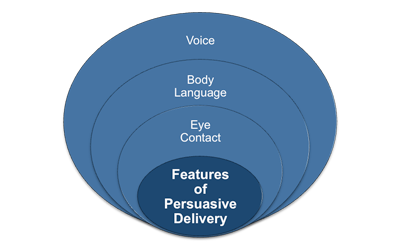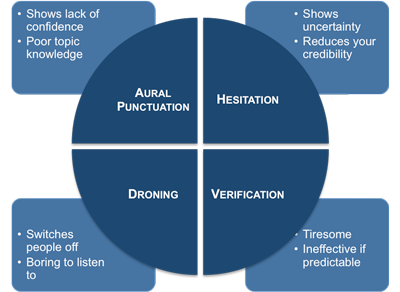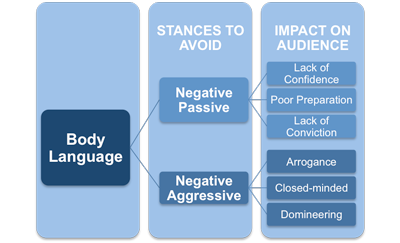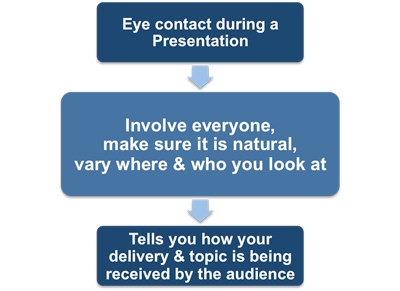Communication Skills - Developing a Persuasive Delivery Style
Developing a persuasive delivery style takes a lot of practice and involves working on your voice, body language, and eye contact with the audience. The different aspects of your delivery may have to alter depending on the size of your audience, so ensure your style is flexible.
 |
Most people are aware that they have certain mannerisms or modes of speech that whilst being perfectly acceptable in conversation can become irritating when they are making a presentation. Some of these mannerisms are the result of nerves and will disappear naturally as you gain confidence, whereas others can only be eradicated by conscious effort and practice.
Voice
One aspect of presentation delivery that almost everyone needs to focus on is avoiding inappropriate verbal mannerisms. These usually take one of four forms: droning, aural punctuation, hesitation, or verification.
 |
Droning refers to speaking without varying the pace of delivery. This is very boring to listen to even if the underlying subject matter is interesting. Try to speed up your delivery when you are saying something relatively straightforward - speeding up when something is easy to understand is quite acceptable.
A simple technique to vary your pace is to use a pause. Pauses can be quite dramatic and good attention-getters, but presenters are often wary of using them. The pause may seem endless to you as a presenter, but in reality it gives the audience time to take your last comments on board and to build up their expectation about what is coming next.
Many presenters fall into the trap of using aural punctuation such as inserting 'Err,' 'Ah,' or 'Um' every time they come to the end of a sentence. One of the most effective ways to break this habit is to take the end of a sentence as a cue to do something else - for example, closing your lips or rubbing your index finger over your thumb.
Hesitation is something else you need to avoid when presenting because it will lower the audience's belief in your knowledge of the topic. It is normally caused by uncertainty about precisely what to say next. The best way to reduce hesitation is to ensure that you are familiar with the material and have conducted adequate rehearsals.
Try to avoid aural punctuation and hesitation, but don't worry too much about them unless you use them to the extent that they become a distraction. You will naturally use them less as you become more experienced and confident as a presenter.
Good presenters often use the occasional verification to confirm that the audience has understood the point made. It usually takes the form of 'Okay?' or 'Right?' You need to ensure that you have eye contact with your audience so that you can see their confirming nods and smiles. You must avoid using it systematically or it will become predictable and tiresome.
If you really want to verify something with your audience then use a more meaningful method - try asking them a question or involving them in a point of conversation. Where you are presenting to an audience that is too large to interact with you should gauge their understanding by reading their body language and facial expressions and by maintaining eye contact.
Most presenters will be concerned about coming across as very different from their normal day-to-day personality because of the risk of appearing slightly ridiculous to people who know them. This is not something you really need to worry about. Even people who know you well accept that when you are making a presentation you will need to appear to be more extrovert and outgoing than normal.
Body Language
Research has shown that body language is an important part of any presentation. Body language can mean different things in different cultures. This section explains aspects of body language communication as it applies in Western society.
You need to be aware of your body language from the moment you stand up until your presentation is complete. Members of your audience will analyze your body language, even if they are unaware of this at the conscious level.
You will probably be aware of the concept of personal space - that area around an individual into which other people should not venture uninvited. Audiences too are very conscious of this space and when presenting you should avoid standing too close to the audience. This distance also creates an effective stage area in which you, the presenter, can perform.
Once you are positioned in the correct zone - this will be further away the larger the audience - there are four main aspects of body language that you should consider: what to do with your eyes, what your facial expressions indicate, the positioning and movement of your body and limbs, and your hand gestures.
The way that you move your body and limbs will have a major influence on how your audience perceives you. When presenting, you will normally be standing, and an ideal stance is with your feet close together and your weight evenly distributed between them.
It is important not to grow roots - don't stand in one position, but try to inject movement as you speak. This helps to add a natural animation to your presentation as the audience will have to adjust their gaze to follow you rather than stay looking at a fixed position.
By developing a practiced way of moving you can add a confident and professional air to your presentation style. Precisely how you choose to move is a personal thing, but try to develop and rehearse your style so that you end up moving without conscious effort.
Whilst it is a good thing to be animated, don't walk around too much or the audience will find it distracting and annoying. One of the best tactics is to use the main features of your presentation as cues for movement. Until you have developed this skill it may be worth annotating your cue cards with movement cues or symbols.
There are two stances that should always be avoided: the negative passive stance and the negative aggressive stance.
The negative passive stance involves you adopting an unbalanced position - perhaps leaning on one leg, with the arms crossed low in front of the body in a protective way. This stance will often be accompanied by lack of eye contact and a nervous vocal style.
It will portray a lack of confidence, often associated with a lack of preparation. Your audience may also see this as a sign that you do not really believe in what you are saying.
The negative aggressive stance involves standing uncomfortably close to the audience with hands on hips and is associated with an arrogant, closed-minded, and domineering attitude. It should be apparent that this style of presentation will not be well received and is unlikely to deliver the intended message. You may occasionally see this style of delivery used in a deliberate way by someone in authority in order to intimidate his or her audience.
 |
Eye Contact
A great deal has been written about eye contact and there are various schools of thought regarding the best ways of using it to engage your audience. Generally speaking the audience will do what you do: if you look out of the window or stare at the floor the audience will do the same thing. If on the other hand you look at members of the audience then they will return your eye contact.
 |
Do not worry too much about the number of seconds that you spend maintaining eye contact; the most important thing is to make eye contact with everyone in the room before your presentation begins. This does not need to last more than a fraction of a second but you must take the whole room in to your glance even when there is a large audience.
It is quite acceptable to do this more than once in order to engage everyone's attention before you begin speaking. The single biggest factor that prevents proper eye contact is presentation nerves. If you are nervous then there is a natural temptation to avoid eye contact. If you have prepared properly and are presenting confidently than your eye contact will be natural and will serve its purpose of engaging with everyone in the room.
As well as engagement, one of the key functions of eye contact is that it enables you to read the audience. You should be looking for signs that people are staying with you and that you have not left a significant number of people behind.
People will usually nod their heads and make eye contact when they are with you. It is when they close their eyes or stare at the floor or out of the window that you can assume that you are losing their interest. The early signs of this happening should encourage you to pause and reengage with the audience either by summarizing what you've already said and using a transition into the next part of the presentation or by clarifying something that is causing confusion.
Whatever you do, do not overreact to any one individual. Some people may genuinely have no interest in the item you're presenting and may be there because they have been told to or for some other purpose.
All these features of your delivery style will be affected by the size of your audience. You will generally need to be more extroverted the larger your audience and it will require more energy and concentration to scan a large audience to make sure that everyone is following your message.
You also need to take into account the likely effect on the audience of what you are presenting. If the implications of your message are going to cause problems for some people in the audience - for example, redundancy or restructuring - then an overly upbeat delivery style will come across as insensitive and antagonistic, alienating those in your audience that are affected.
You may also be interested in:
Giving a Management Presentation | Styles of Presenting | Cue Card Guidelines | How to Rehearse | Reading Your Audience | Retaining Control in a Presentation | Question and Answer Session | Importance of the Presentation Venue | Presentation Venue Layout.



